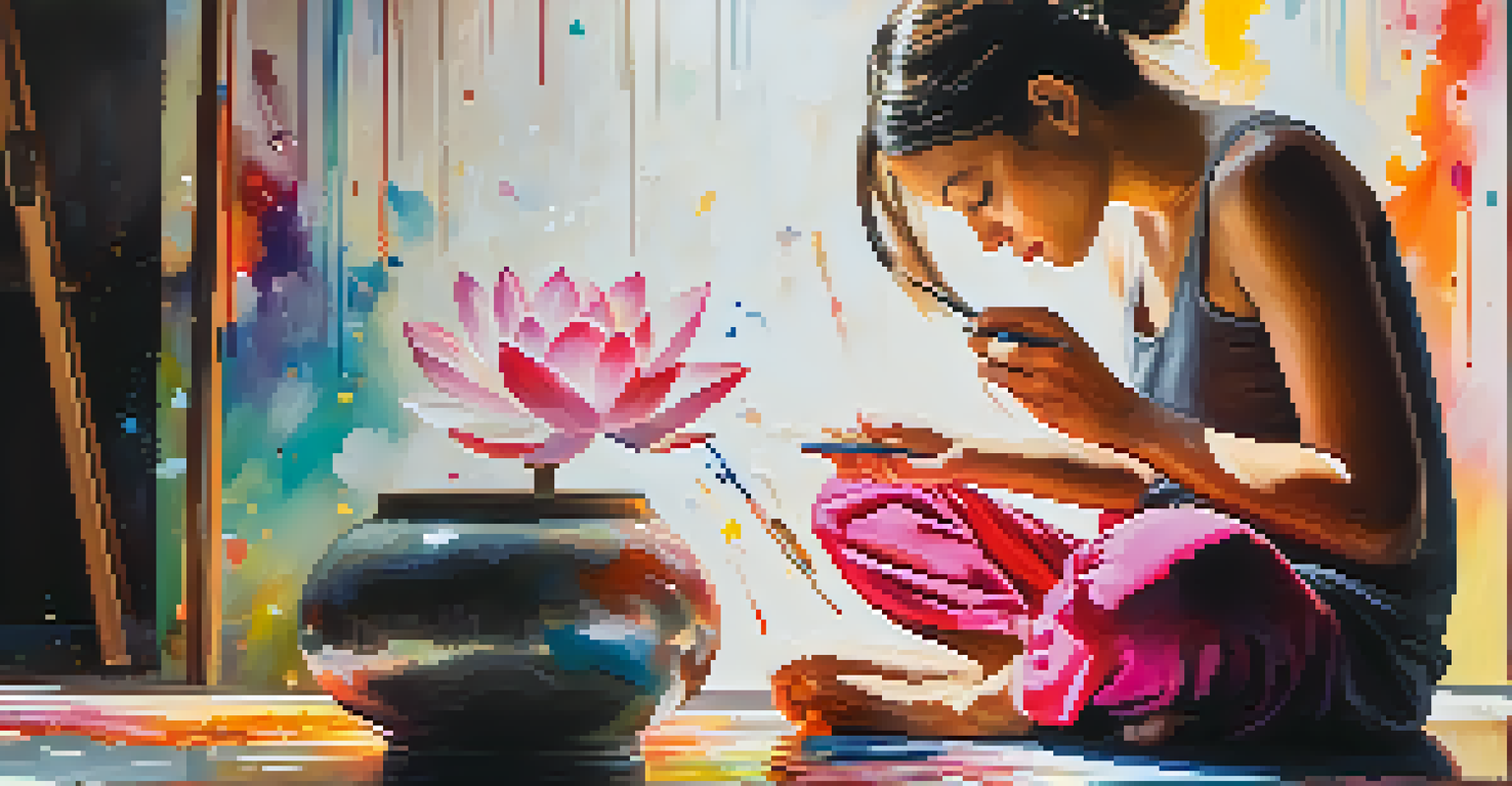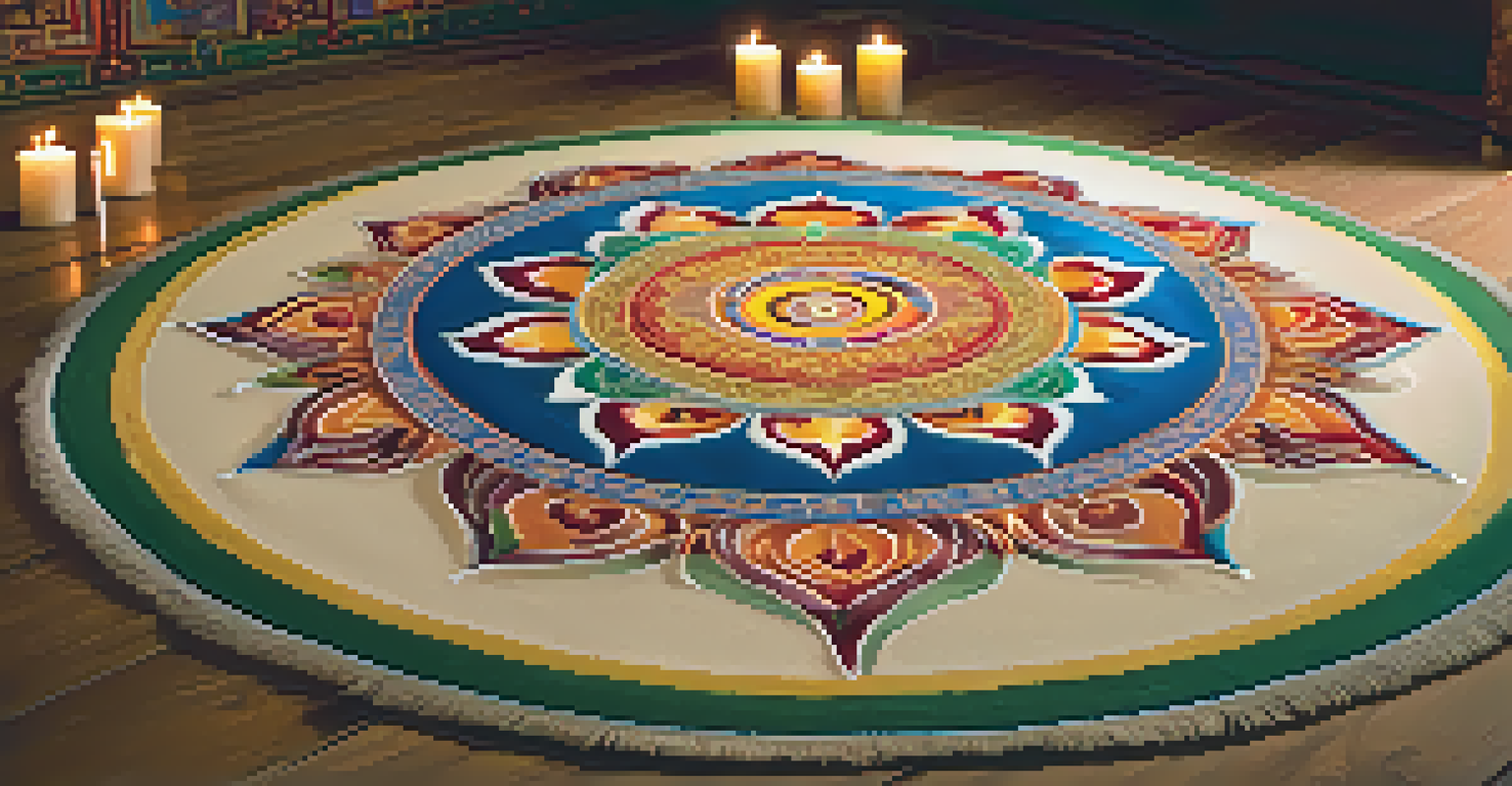The Intersection of Art and Spirituality in Buddhism

Understanding Buddhism's Core Spiritual Principles
At the heart of Buddhism lies a quest for enlightenment, a state of profound understanding and liberation from suffering. This spiritual journey emphasizes mindfulness, compassion, and the interconnectedness of all beings. These principles not only guide practitioners in their daily lives but also inspire artistic expressions that reflect these deep values.
Art is the most beautiful of all lies.
For instance, the concept of impermanence (anicca) is often depicted in Buddhist art through transient materials or themes that evoke the fleeting nature of existence. Artists draw from their spiritual experiences, aiming to convey the beauty and sadness of life’s ephemeral moments. This creates a rich tapestry of meaning that resonates with both practitioners and art enthusiasts alike.
Moreover, meditation plays a significant role in both spirituality and artistic creation. A meditative state can lead to enhanced creativity, allowing artists to connect with their inner selves and express profound insights. In this way, art becomes a form of meditation, where the act of creation itself fosters spiritual awakening.
The Role of Art in Buddhist Practices
Art in Buddhism serves as a powerful tool for teaching and reinforcing spiritual concepts. From intricate mandalas to serene Buddha statues, each piece is meticulously crafted to evoke a sense of peace and contemplation. These artworks are not just decorative; they are integral to rituals and meditation practices, guiding practitioners on their spiritual path.

Take, for example, the creation of sand mandalas by Tibetan monks. This elaborate process involves painstakingly placing colored sand to form intricate patterns that symbolize the universe. Once completed, the mandala is destroyed in a ritual that signifies the impermanence of life, encapsulating a key Buddhist teaching in a beautiful artistic form.
Art Reflects Buddhist Principles
Buddhist art embodies core spiritual concepts such as impermanence and interconnectedness, serving as a visual guide for practitioners.
Through these practices, art becomes a bridge between the material and spiritual worlds. It invites individuals into a deeper understanding of their beliefs, encouraging reflection and connection with the teachings of Buddhism. In this sense, art is not merely an aesthetic experience; it is a meaningful part of the spiritual journey.
Symbolism in Buddhist Art and Its Spiritual Significance
Buddhist art is rich with symbolism, each element carefully chosen to convey spiritual truths. Common symbols include the lotus flower, representing purity and enlightenment, and the wheel of Dharma, symbolizing the path to enlightenment. These symbols serve as reminders of the core teachings of Buddhism, helping practitioners focus their intentions during meditation.
Meditation is the discovery that the point of life is always in the present moment.
For example, the lotus grows in muddy waters yet rises beautifully to bloom above the surface. This powerful metaphor illustrates the potential for spiritual growth amid suffering and challenges. Artists use this imagery to inspire hope and resilience, inviting viewers to reflect on their own journeys.
Additionally, the use of color in Buddhist art is deeply symbolic. Gold often represents enlightenment, while blue can signify compassion. By incorporating these colors into their work, artists create a visual language that speaks to the heart, enhancing the spiritual experience of the observer.
Meditation as an Artistic Practice
Meditation and art often intertwine in Buddhist practice, as both require deep focus and a connection to the present moment. Artists frequently enter a meditative state while creating, allowing intuition and spirituality to guide their hands. This fusion of meditation and creativity fosters a profound sense of peace and clarity, resulting in artworks that resonate with viewers on a spiritual level.
For instance, the act of painting or sculpting can be seen as a form of mindfulness meditation. As artists engage with their materials, they cultivate awareness of their thoughts and feelings, transforming them into tangible expressions. This not only enhances the artistic process but also deepens the artist's spiritual practice.
Meditation Enhances Artistic Expression
The meditative state of artists allows for deeper creativity, making the act of creation a spiritual journey in itself.
Through this lens, art becomes a reflection of the inner self, a manifestation of spiritual insights and experiences. Each brushstroke or chisel mark carries the energy of the artist’s meditative state, inviting observers to engage with the art in a meaningful way. In this way, the creative process itself becomes a spiritual journey.
The Influence of Nature on Buddhist Art
Nature plays a vital role in Buddhist art, often serving as a source of inspiration and a symbol of spiritual growth. Many Buddhist artists draw from the natural world to illustrate concepts such as harmony, balance, and interconnectedness. This connection to nature reflects the Buddhist understanding that all life is interdependent and worthy of respect.
Consider the serene landscapes depicted in traditional Japanese Zen paintings. These artworks often feature mountains, rivers, and trees, inviting viewers to contemplate the beauty of the natural world. Such scenes encourage a sense of tranquility and mindfulness, reminding us of our place within the greater universe.
Moreover, nature is often used as a metaphor for spiritual principles. For example, a tree can symbolize the path to enlightenment, with its branches representing the various routes one can take. By incorporating natural elements into their art, Buddhist artists create a dialogue between the spiritual and the natural, inviting reflection and connection.
Modern Interpretations of Buddhist Art
In recent years, contemporary artists have embraced Buddhist themes and techniques, creating a new wave of artistic expression. These modern interpretations often blend traditional motifs with innovative approaches, reflecting the evolving nature of spirituality in today’s world. Artists are exploring ways to make Buddhist principles more accessible and relevant to contemporary audiences.
For example, some artists are using digital media to create immersive experiences that allow viewers to engage with Buddhist teachings in innovative ways. This fusion of technology and spirituality opens up new avenues for connection and understanding, making the essence of Buddhism more relatable to a diverse audience.
Modern Art Revitalizes Buddhism
Contemporary artists are blending traditional Buddhist themes with modern techniques, making the teachings more accessible to today's audiences.
Additionally, modern artists often address social issues through a Buddhist lens, using their work to promote compassion and awareness. This contemporary approach not only honors the rich history of Buddhist art but also ensures its relevance in a rapidly changing world.
The Future of Art and Spirituality in Buddhism
As we look to the future, the intersection of art and spirituality in Buddhism continues to evolve, influenced by cultural shifts and technological advancements. Artists are increasingly exploring how to convey Buddhist teachings in a way that resonates with younger generations, encouraging a renewed interest in spiritual practices. This ongoing dialogue between tradition and innovation enriches the artistic landscape.
Moreover, the rise of social media and online platforms allows artists to share their work with a global audience, fostering a greater appreciation for Buddhist art and its spiritual significance. This accessibility opens up conversations about spirituality, inviting diverse perspectives and interpretations.

Ultimately, the future of art and spirituality in Buddhism lies in the hands of the artists who continue to push boundaries and explore new mediums. By doing so, they keep the teachings of Buddhism alive and relevant, inviting all of us to engage with these profound ideas in our own lives.